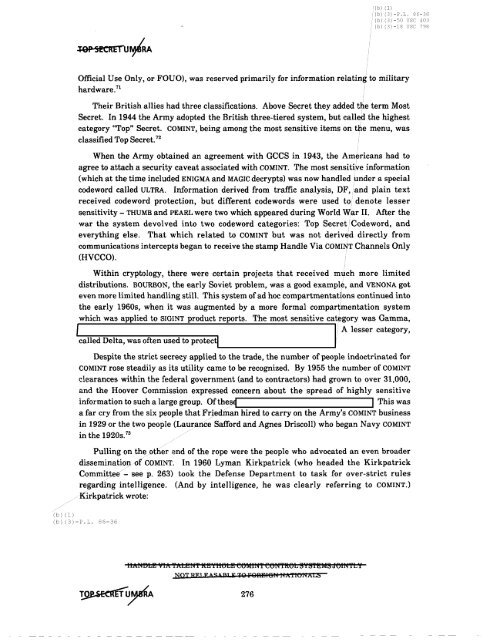American Cryptology during the Cold War - The Black Vault
American Cryptology during the Cold War - The Black Vault
American Cryptology during the Cold War - The Black Vault
You also want an ePaper? Increase the reach of your titles
YUMPU automatically turns print PDFs into web optimized ePapers that Google loves.
(b) (1)<br />
(b) (3) -P.L. 86-36<br />
(b) (3) -50 USC 403<br />
(b) (3) -18 USC 798<br />
Official Use Only, or FOUO), was reserved primarily for information relating to military<br />
hardware. 71<br />
<strong>The</strong>ir British allies had three classifications. Above Secret <strong>the</strong>y added <strong>the</strong> term Most<br />
Secret. In 1944 <strong>the</strong> Army adopted <strong>the</strong> British three-tiered system, but called <strong>the</strong> highest<br />
category "Top" Secret. COMINT, being among <strong>the</strong> most sensitive items on <strong>the</strong> menu, was<br />
classified Top Secret.72<br />
When <strong>the</strong> Army obtained an agreement with accs in 1943, <strong>the</strong> <strong>American</strong>s had to<br />
agree to attach a security caveat associated with COMINT. <strong>The</strong> most sensitive information<br />
(which at <strong>the</strong> time included ENIGMA and MAGIC decrypts) was now handled under a special<br />
codeword called ULTRA. Information derived from traffic analysis, DF,and plain text<br />
received codeword protection, but different codewords were used to denote lesser<br />
sensitivity - THUMB and PEARL were two which appeared <strong>during</strong> World <strong>War</strong> II. Mter <strong>the</strong><br />
war <strong>the</strong> system devolved into two codeword categories: Top Secret Codeword, and<br />
everything else. That which related to COMINT but was not derived directly from<br />
communications intercepts began to receive <strong>the</strong> stamp Handle Via COM!NT Channels Only<br />
(HVCCO).<br />
Within cryptology, <strong>the</strong>re were certain projects that received much more limited<br />
distributions. BOURBON, <strong>the</strong> early Soviet problem, was a good example, and VENONA got<br />
even more limited handling still. This system ofad hoc compartmentations continued into<br />
<strong>the</strong> early 1960s, when it was augmented by a more formal compartmentation system<br />
which was applied to SIGINT product reports. <strong>The</strong> most sensitive category was Gamma,<br />
A lesser category,<br />
called Delta, was often used to protect<br />
"-----------------'<br />
Despite <strong>the</strong> strict secrecy applied to <strong>the</strong> trade, <strong>the</strong> number of people indoctrinated for<br />
COMINT rose steadily as its utility came to be recognized. By 1955 <strong>the</strong> number of COMINT<br />
clearances within <strong>the</strong> federal government (and to contractors) had grown to over 31,000,<br />
and <strong>the</strong> Hoover Commission expressed concern about <strong>the</strong> spread of highly sensitive<br />
information to such a large group. Of<strong>the</strong>~~<br />
I This was<br />
a far cry from <strong>the</strong> six people that Friedman hired to carryon <strong>the</strong> Army's COMINT business<br />
in 1929 or <strong>the</strong> two people (Laurance Safford and Agnes Driscoll) who began Navy COMINT<br />
in <strong>the</strong> 1920s. 73<br />
Pulling on <strong>the</strong>o<strong>the</strong>r end of <strong>the</strong> rope were <strong>the</strong> people who advocated an even broader<br />
disseminatioI).of COMINT. In 1960 Lyman Kirkpatrick (who headed <strong>the</strong> Kirkpatrick<br />
Committee- see p. 263) took <strong>the</strong> Defense Department to task for over-strict rules<br />
regarding intelligence. (And by intelligence, he was clearly referring to COMINT.)<br />
Kirkpatrick wrote:<br />
(b) (1)<br />
(b) (3)-P.L. 86-36<br />
llA:NBLI!l VIA: 'fA:U:lff KI!lYH6LI!l e6MHff e6lffIt6L 8YMI!lM8J6Uf'fLY<br />
NOTRE} EASAW i'l'QlilQRBI8HHA:'l'IONALS<br />
276
















